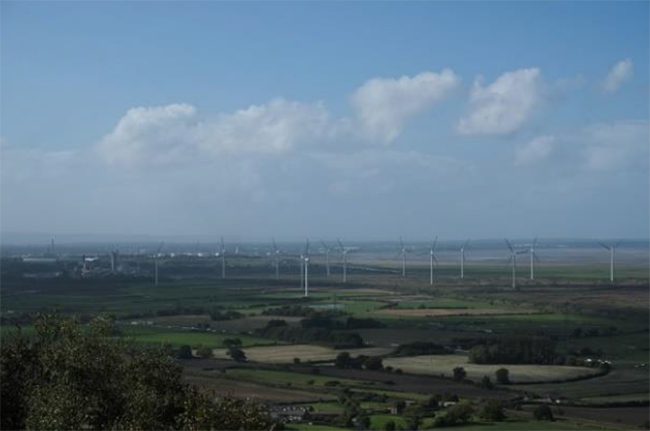Cheshire lays foundations for a sustainable future with green light given for world-class geoenergy research site
02/07/2019 By BGS Press
Cheshire West and Chester Council (CWACC) councillors have unanimously approved BGS’s planning application to site a UK Geoenergy Observatory at Ince Marshes in the north of the county.
The decision will see some 50 boreholes drilled down to 1200 m around a 12 km2 area, enabling scientists to gain the clearest picture yet of the underground environment.
The boreholes will be installed with some £2.5 million worth of scientific sensors, which will observe in unprecedented detail how the underground system works. The sensors will generate millions of terabytes of data on the chemical, physical and biological properties of the rocks over a 15-year period, providing the nation with the knowledge it needs to unlock new clean, green, low-carbon energy technologies.
The UK’s main funder in environmental science, the Natural Environment Research Council (NERC), has commissioned the £31 million UK Geoenergy Observatories to keep the UK at the cutting edge of geoscience and energy innovation and to provide the important knowledge needed to move the UK towards a low-carbon economy. The BGS, the UK’s principal provider of impartial geological evidence since 1835, will operate the observatories on behalf of the whole of the UK and the geoscience community.
More and more of the solutions to decarbonising our energy supply will need to come from beneath our feet. Ensuring we take forward these solutions in a sustainable way means understanding more about the system. Second by second, minute by minute, day by day, we’ll be measuring the pulse of the Earth in a way that the scientific community simply hasn’t been able to do until now.
The UK Geoenergy Observatory in Cheshire will be a world first in its ability to observe the underground environment so closely and consistently. What we learn in Cheshire should provide a breakthrough in our understanding of how the whole underground system works.
Prof Mike Stephenson, BGS Chief Scientist.
The study will involve the drilling of 50 boreholes from between 50 and 1200 m deep across the 12 km2 study area. They will contain a network of 1800 seismic sensors and 5 km of fibre-optic cable that can measure earth tremors 1000 weaker than you can feel. They will allow thousands of water samples to be taken over the next 15 years from between 50 and 400 m below the surface. Some 8 km of borehole drilling will generate 3000 m of rock core, which will be taken back to the BGS’s national core scanning facility for laboratory analysis. All the data will be made free and open via a publicly owned website.
The UK Geoenergy Observatory at Ince Marshes will make Cheshire home to the best-characterised rock mass in the world, providing a world-class environmental baseline for the geological environment.
The Cheshire site will be one of two observatories in the UK. The other is being drilled in Glasgow and comprises 12 boreholes over a 4 km2 area. The Glasgow observatory will allow the UK’s earth science community to probe whether warm water within the UK’s disused mine workings can generate a geothermal heat source that could become a sustainable part of the energy mix.
NERC’s investments will equip the UK with a unique capability to investigate geological processes at depth. It will enable world-leading research, which will ensure that the best possible geological evidence is available to underpin decisions and regulatory controls around the management of the environment and its natural resources, as government, industry, regulators and academia look at how the underground might be used to power the future.
Prof Duncan Wingham, NERC Executive Chair.
NERC consulted with the UK geoscience community in 2015 to determine what new evidence would be required. Professor of geological engineering at the University of Strathclyde, Professor Zoe Shipton, chaired the group of independent scientists who worked with NERC to write the research agenda for the UK Geoenergy Observatories.

Ince Marshes in north Cheshire. © Peter Corcoran.
Delivering the science depends on learning from research in a location typical of the demands people put on their environment. The UK Geoenergy Observatories will enable scientists to answer a range of geoscience questions relating to techniques such as storing carbon, utilising rocks as a battery store for solar, wind and tidal energy, geothermal energy, and shale gas. The observatories will build up a really good picture of natural conditions in a variety of rock types and how they respond to change, and apply this new understanding throughout the UK.
Prof Zoe Shipton, professor of geological engineering at the University of Strathclyde.
The UK Geoenergy Observatories will ensure that we continue to lead the way in environmental impact monitoring. It will improve our understanding of the connections and pathways and therefore identify what else we need to monitor from an environmental point of view. It will become a world-class showcase for how monitoring should be done.
Prof Mike Kendall, professor of geophysics at the University of Bristol.
The £31 million investment is part of the UK Government’s £6 billion Plan for Growth in Science and Innovation. The UK Geoenergy Observatories will help to ensure that the UK continues to lead the world in research, innovation, regulation and engineering in geoscience.
Our Chester team has been working to bring this important investment to the Cheshire Science Corridor for the last three years. Investment in the science corridor is vital for the continuation of Cheshire and the north-west’s world-class standing and capability in science and engineering.
David Grove, director at technical advisor Ramboll, which is project managing the planning, engineering and construction of the facility.
The proposal is an opportunity for Cheshire to provide a game-changing research facility, which will help to underpin future policy making and inform decisions on future energy mix in the UK.
Mike Hopkins, planning director at JLL, who have worked alongside Ramboll managing the planning application.
The Cheshire Science Corridor — with Thornton Science Park at its heart — is rapidly becoming recognised as leading the UK’s clean-growth agenda. Building upon our record for delivering world-leading innovation, our academic expertise and the presence of an industrial cluster demonstrating its commitment to decarbonisation, this exciting initiative will bring the world’s best academics in geoscience and a £20 million investment to Ince Marshes to inform the future of clean energy security for the UK and further afield.
Prof Joe Howe, executive director of Thornton Energy Research Institute at the University of Chester’s Thornton Science Park.
For more information watch Imagine a cube of rock or visit ukgeos.ac.uk
Relative topics
For further details or to arrange media interviews please contact:
Cristina Chapman, British Geological Survey, Keyworth, Nottingham, NG12 5GG
Office +44 (0)115 936 3066 Mobile: + 44 (0)7970 229729
Email: crisc@bgs.ac.uk
The British Geological Survey
The British Geological Survey (BGS) is a world leading applied geoscience research centre that is part of UK Research and Innovation (UKRI) and affiliated to the Natural Environment Research Council (NERC). BGS core science provides objective and authoritative geoscientific data, information and knowledge to inform UK Government on the opportunities and challenges of the subsurface. It undertakes national and public good research to understand earth and environmental processes in the UK and globally. The BGS annual budget of approximately £60 million pa is funded directly by UKRI, as well as research grants, government commissions and private sector contracts. Its 650 staff work across the UK with two main sites, the head office in Nottingham and Lyell Centre, a joint collaboration with Heriot-Watt University in Edinburgh. BGS works with more than 150 private sector organisations, has close links to 40 universities and sponsors about 100 PhD students each year. Please see www.bgs.ac.uk.
The Natural Environment Research Council
NERC is the UK’s main agency for funding and managing research, training and knowledge exchange in the environmental sciences. Our work covers the full range of atmospheric, Earth, biological, terrestrial and aquatic science, from the deep oceans to the upper atmosphere and from the poles to the equator. We coordinate some of the world’s most exciting research projects, tackling major issues such as climate change, environmental influences on human health, the genetic make-up of life on Earth, and much more. NERC is part of UK Research & Innovation, a non-departmental public body funded by a grant-in-aid from the UK government.
Ramboll
Ramboll is a leading engineering, design and consultancy company with 15 000 staff across 300 offices in 35 countries in the UK, the Nordics, North America, continental Europe, the Middle East and Asia-Pacific. Ramboll works across the following markets: buildings; transport; planning and urban design; water; environment and health; energy, and management consulting. Ramboll was appointed to project manage the engineering design of the facility and to prepare all the necessary studies and documentation to support a full planning application. The multidisciplinary team includes global planning and property consultants JLL and cost managers Turner & Townsend.
The UK Geoenergy Observatories
The UK Geoenergy Observatories will establish new centres for research into the subsurface environment and provide opportunities to research how natural processes can control resource availability, and how natural resources can be used responsibly for present and future generations. The knowledge they generate will contribute to an understanding of new low-carbon energy technologies both in the UK and internationally. The capital project is NERC’s response to the British Government’s announcement in the 2014 Autumn Statement that it would create world-class subsurface energy research test centres through NERC, operated by the British Geological Survey.
Photographs are available from our ftp server: ftp://ftp.bgs.ac.uk/pubload/bgspress. These are provided free for media use with copyright acknowledgement.



